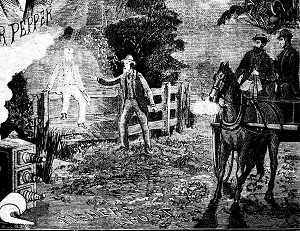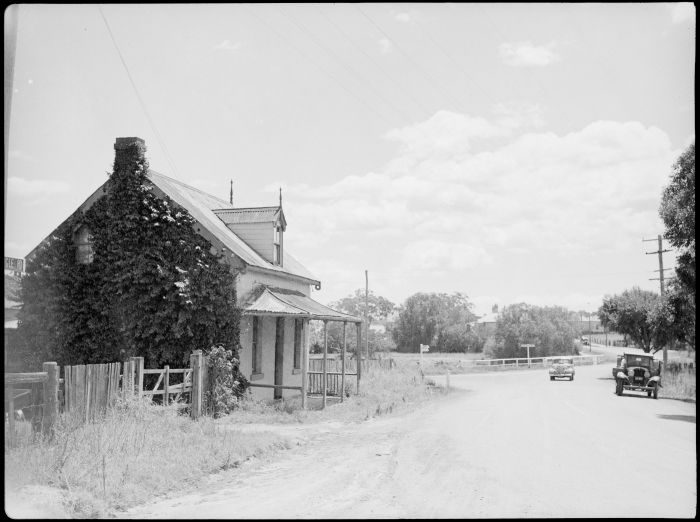Frederick George James Fisher was born on August 28th, 1792. By his early twenties he was a shopkeeper, unmarried, but thought to be the father of two children. Either innocently or deliberately, Fred Fisher obtained forged bank notes through his business for which he was arrested and tried at the Surrey Gaol Delivery on July 26, 1815 and sentenced to fourteen years transportation to Australia.
By 1822 Fred Fisher has served half his sentence and applied for a ticket-of-leave and permission to purchase property. Among other properties, Fred Fisher secured a farm at Campbelltown. His neighbour was a man named William George Worrall, known to be an honest and industrious man. In 1825 Fred Fisher and a local carpenter, William Brooker, had an argument over money, whereby Fisher pulled a knife. William Brooker was not badly hurt, however Fred Fisher received a light prison sentence. Worried about his property, Fred Fisher gave George Worrall power of attorney during his imprisonment. Fisher served his sentence and returned to town a short time later.
On the evening of June 17, 1826, Fred Fisher disappeared, he left his home in Campbelltown and was not seen again. George Worrell announced that Fred had sailed for England because he was concerned about a forgery charge recently made against him. Three weeks later after Fred Fisher’s disappearance, George Worrall sold Fisher’s horse and personal belongings, claiming Fred Fisher had sold them to him before he set sail.
Several local townspeople became suspicious and on September 17, 1826, George Worrall was arrested on suspicion of Fred Fisher’s murder. Worrall claimed he had not murdered Fred Fisher, but that four other men had in fact committed the crime. All four men were then arrested.
Late one night in October 1826, a wealthy and respectable Campbelltown farmer, John Farley, stumbled into a local hotel in a state of shock, and claimed he had seen the ghost of Frederick Fisher. The ghost according to John Farley, had been sitting on the rail of a bridge and had pointed to a paddock down the creek, then faded away.

Illustration by British scientist John Henry “Professor” Pepper, who in 1879 created the theatrical production “Fisher’s Ghost”, complete with special “ghost” effects on stage.
Source: https://www.nla.gov.au/stories/blog/behind-the-scenes/2017/10/30/finding-frederick-fisher
The story continues on October 25, 1826, two young boys were returning home across Fisher’s farm and noticed blood stains on a fence. On closer investigation, a lock of hair and a tooth were also found. A local constable searched the area to no avail and decided to call in an Aboriginal tracker from Liverpool. On testing the water from puddles in the area, the tracker announced ‘white fellow’s fat here!’ Fred Fisher’s remains were found lying in a shallow grave on George Worrall’s land.
George Worrall sat for trial in a criminal court on February 2, 1827. He was found guilty and sentenced to death by hanging on February 5, 1827. On the scaffold, Worrall confessed he had murdered Fred Fisher by mistake, thinking him a horse in the wheat crop, however, this confession was never believed by the locals. It is thought George Worrall had assumed when he was appointed Fred Fisher’s agent, that all of Fisher’s property belonged to him. On Fisher’s release from prison, George Worrall murdered him to fully obtain his property.
What then of John Farley’s Ghost story? Why was it not used at the trial? Apparently any tales of the supernatural were not permitted in a Court of Law and could not be used as evidence against the accused.

Fisher’s Ghost Bridge, Campbelltown NSW, circa 1945. Historic Emily Cottage featured in foreground. Source: https://www.nla.gov.au/stories/blog/behind-the-scenes/2017/10/30/finding-frederick-fisher
Many local residents believe the ghost of Fred Fisher haunts the Campbelltown Town Hall, which is built on land where Fred Fisher and George Worrall’s land intersected. Fred Fisher was buried in St Peters graveyard by his brother Henry however, no headstone was ever erected.
The legend of Fred Fisher has captured the imagination of generations. There are many tales and rumours relating to the sequence of events leading up to the subsequent trial – the murder of Frederick Fisher, the appearance of his ghost, the arrest of five men and the eventual hanging of one. Every year in November Campbelltown hold the famous Fisher’s Ghost Festival, celebrating the man, the ghost and the legend.
First published as a brochure by the Communications and Marketing Department of Campbelltown City Council.
Frederick Fisher and the Legend of Fisher’s Ghost
Bibliography
Colonial days in Campbelltown : the legend of Fisher’s ghost / by Verlie Fowler. (Campbelltown, N.S.W. : Campbelltown & Airds Historical Society, 1991). Copies of this book are available in the local studies collection, Campbelltown City Library.
‘The Harrow: the Fisher’s Ghost Pub’ / by David Patrick. Grist Mills, Volume 11 No 3, November 1998. Copies of this article are available in the local studies collection, Campbelltown City Library.
The History Buff: Campbelltown City Library Local Information Blog